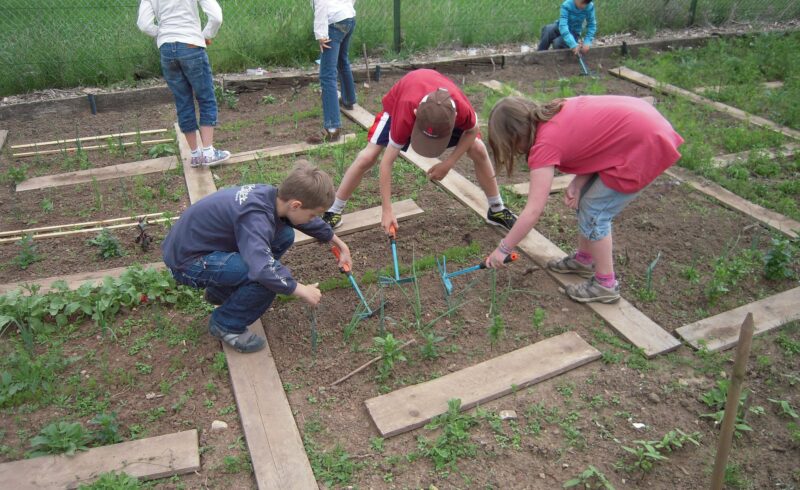
Picture this – a group of second graders collects caterpillars and eggs on milkweed and other flowers in an outdoor butterfly garden. Inside the classroom they’ll watch them develop and change, learning about habitats, metamorphosis, and the life cycle. A few weeks later they will release adult butterflies, watching in wonder as colorful wings beat against the sky. Through the process, the children will gain an understanding of science that goes deeper than a textbook.

Imagine….fifth-grade students plant vegetable seedlings in the ground, learning how Victory Gardens were grown during WWII. They chart, grow and harvest this garden, learning about abiotic and biotic environments – and how plants affect an ecosystem.
What if a third-grade class harvested popcorn from their school garden, then in science class experimented to discover which kind popped better – the school corn or Orville’s? After much tasting and fun, they’ve learned how products can differentiate, and in the spring they dig holes, and carefully place their seeds inside, knowing that in the fall a new group of third graders will harvest a fresh crop.
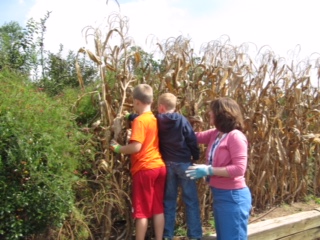
Administrators and teachers all across the nation are making a difference in children’s lives by providing gardens on school property. Whether it be a butterfly garden, a vegetable garden, or an orchard, the learning that takes place here will stay with kids the rest of their lives.
One school that uses the examples listed above is Oakview Elementary in Simpsonville, SC, where my son attended for six years, and my daughter still attends. Oakview currently has a butterfly garden, a garden habitat consisting of an apple orchard and a cotton/popcorn patch that is rotated yearly. Their latest project is a vegetable garden, through which they will cross subject areas, bridging social studies and science, teaching kids about WWII Victory Gardens and ecosystems.
Studies show student experiences in the garden result in improved academics, better eating habits, greater environmental stewardship, and ultimately healthier, more secure and engaged communities. Nationwide school administrators are waking up to all the possibilities a garden can teach students, resulting in a 44% increase of gardens throughout our nation’s school systems over a short span of several years’ time.
The beautiful thing about a garden is that it can come in all shapes and sizes. Container gardens, raised beds, vertical and growing walls are just some ways to maximize space. Gardens can be grown in hanging baskets, gutters, old tires, cans, just about any place kids can imagine – all while they’re learning about ecosystems, getting fresh air and exercise, and having an unforgettable experience.
According to Charnley DeMeritt, Science Lab teacher of Oakview Elementary, a garden is a collaboration and can be done in stages. Oakview’s first garden, the butterfly garden, was the first habitat created by Kathy Miller and many local partners during the 1999 school year, and students were heavily involved in its planning, design, and planting. DeMerritt states, “Its purpose then and now is to immerse students in a real-world learning environment as they learn different environmental content.” DeMeritt, along with other teachers, parents and Oakview administrators make sure the students stay involved throughout the school year. There is an after school garden club for students, and community members support/maintain the garden throughout the year, including summer volunteering and Saturday Garden Workdays.
Oakview’s new vegetable garden has already begun, as the beds are ready and the first round of seedlings are being grown in the science lab. Fifth-grade students will use 4 of the 8 beds for their Victory Garden and second graders will use the other 4 beds to grow vegetables as part of their social studies curriculum, connecting the idea of community – farm-to-table.
“It will be an experimental summer as we see what grows and what doesn’t, but the future goal is to have bountiful harvests so we can use some in our school kitchen and donate some to a local food bank,” DeMerritt says.
Students involved from the planning stages to growing and harvesting their own gardens for school lunches? You can’t get more locally sourced than that.
What kinds of gardens would you like to see in your local schools?
For more information on school gardens:
https://www.realschoolgardens.org/
https://www.kidsgardening.org/article/container-gardening-guide
https://edibleschoolyard.org/
https://scfarmtoinstitution.com/
Written by Irena Tervo






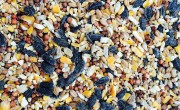


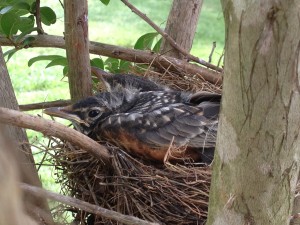
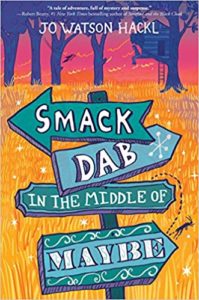
2 Comments
This is a beautiful school filled with beautiful children from beautiful families and instructed with beautiful staff and assistants led by beautiful administrators and community! I was honored to serve as their first administrator and this place will always hold prominence in my memory and its people will hold prominence in my heart!! So proud of you Oakview!! Continue to let your branches grow stronger and firmer!
We’re delighted to highlight the wonderful work at your school. We hope you’ll keep us posted as your garden continues to flourish.